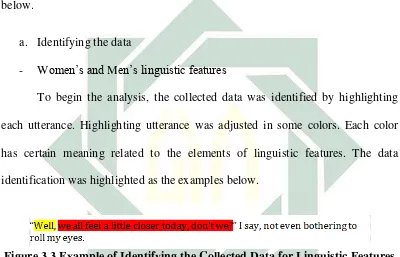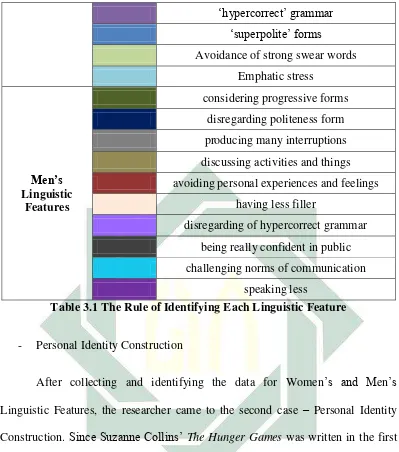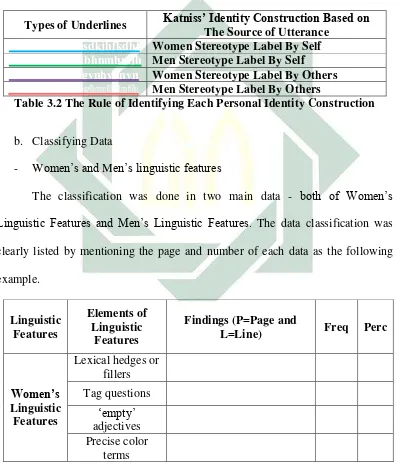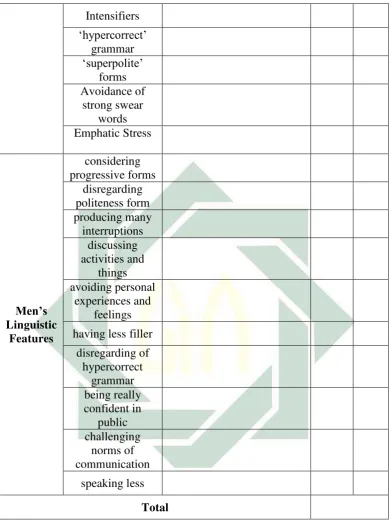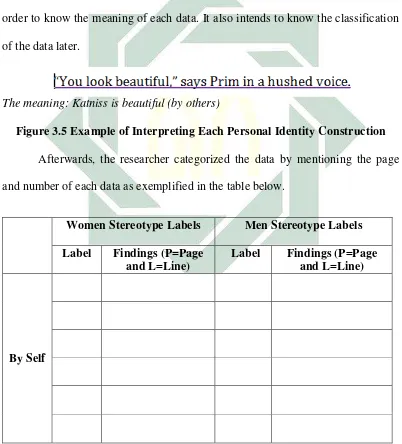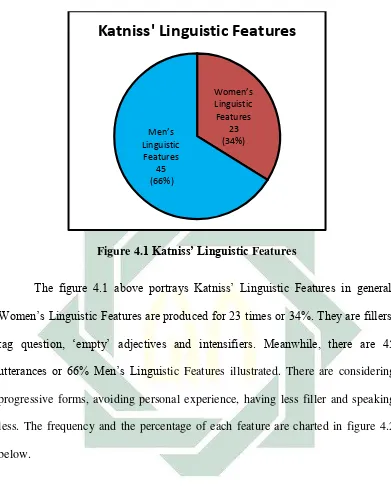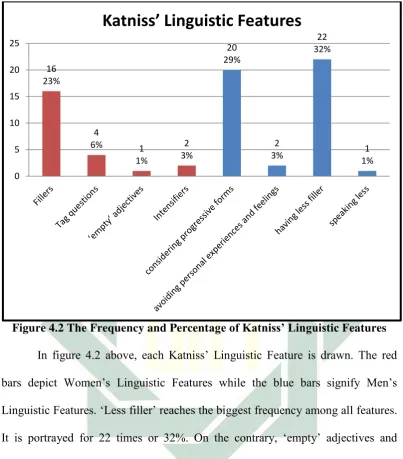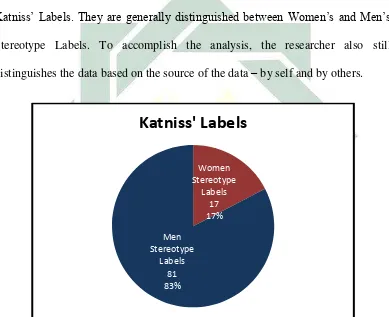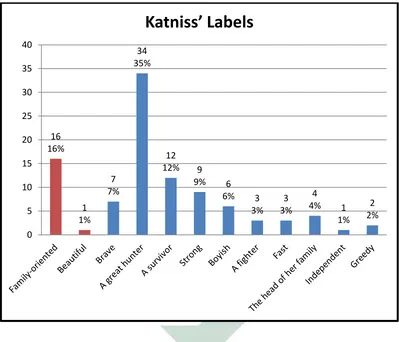THESIS
Submitted as Partial Fulfillment as the Requirements for the Sarjana Degree of English Department Faculty of Letters and Humanities UIN Sunan Ampel
Surabaya
By:
Nafilaturif’ah
Reg. Number A33213069
ENGLISH DEPARTMENT
FACULTY OF ARTS AND HUMANITIES
THE STATE ISLAMIC UNIVERSITY OF SUNAN AMPEL
SURABAYA
THESIS
Submitted as Partial Fulfillment as the Requirements for the Sarjana Degree of English Department Faculty of Letters and Humanities UIN Sunan Ampel
Surabaya
Supervised by:
Murni Fidiyanti, M.A.
NIP: 198305302011012011
By:
Nafilaturif’ah
Reg. Number A33213069
ENGLISH DEPARTMENT
FACULTY OF ARTS AND HUMANITIES
THE STATE ISLAMIC UNIVERSITY OF SUNAN AMPEL
SURABAYA
ABSTRACT
Nafilaturif’ah. 2017. Katniss Everdeen‟s Linguistic Features and Personal Identity Construction in Suzanne Collins‟ The Hunger Games. English Department, Faculty of Arts And Humanities. The State Islamic University of Sunan Ampel Surabaya.
The advisor: Murni Fidiyanti, M. A.
Key words: identity construction, linguistic features, label, gender stereotype
Because gender stereotype gets much attention among numerous academicians, this thesis examines it through personal identity construction which
is concentrated on Katniss’ label. Label is bounded on women’s and men’s stereotype labels. In addition, Katniss’ linguistic features are also investigated
since one of linguistic devices which can index identity is language use. This thesis precisely adopts linguistic features as the linguistic device evaluated.
Lakoff’s theory of Women’s Linguistic Features is applied. Holmes (1992), Sandriani (2012) and Wright (2002)’s features of male’s language are also
utilized. Besides, indexicality principle is also taken to create Katniss’ personal
identity. Several Newman et al (2008)’s characteristics of gender stereotype are
also used to analyze Katniss’ characteristics. Qualitative content analysis and
descriptive research designs are selected to investigate Katniss’ utterances which
consist of linguistic features and labels. The researcher herself becomes the only instrument – human instrument. Reading and selecting the entire text of The Hunger Games become the steps of data collection. Then, the procedures of data analysis contain identifying, classifying and elaborating the data. Drawing the conclusion is also the last step required.
23 utterances of women’s linguistic features and 45 utterances of men’s linguistic features are found. Moreover, there are also 17 women’s stereotype labels and 81 men’s stereotype labels. Those results eventually bring Katniss to her men’s stereotype characteristics with 126 utterances rather than her women’s stereotype characteristics which are just 40 utterances. Katniss’ is ultimately
INTISARI
Nafilaturif’ah. 2017. Katniss Everdeen‟s Linguistic Features and Personal
Identity Construction in Suzanne Collins‟ The Hunger Games. Sastra Inggris, Fakultas Adab dan Humaniora. Universitas Islam Negeri Sunan Ampel Surabaya.
Pembimbing: Murni Fidiyanti, M. A.
Kata kunci: pembuatan identitas, keistimewaan-keistimewaan bahasa, label, stereotype jenis kelamin
Karena stereotype jenis kelamin mendapat banyak perhatian di antara banyak akademisi, skripsi ini memeriksanya melalui pembuatan identitas pribadi yang dipusatkan pada label Katniss. Label dibatasi pada label stereotipe perempuan dan laki-laki. Selain itu, keistimewaan-keistimewaan bahasa dari Katniss juga diselidiki karena salah satu perlengkapan-perlengkapan bahasa yang dapat menyusun identitas adalah penggunaan bahasa. Skripsi ini dengan tepat mengambil keistmewaan-keistmewaan bahasa sebagai perlengkapan bahasa yang dievaluasi.
Teori Lakoff untuk Keistimewaan-Keistimewaan Bahasa Perempuan dipakai. Keistimewaan-keistimewaan bahasa laki-laki dari Holmes (1992), Sandriani (2012) dan Wright (2002) juga digunakan. Di samping itu, dasar penyusunan juga diambil untuk membuat identitas pribadi Katniss. Beberapa sifat-sifat untuk stereotipe jenis kelamin dari Newman, dkk (2008) juga digunakan untuk menganalisa sifat-sifat Katniss. Bentuk penelitian analisa isi kualitatif dan deskriptif dipilih untuk menyelidiki ungkapan-ungkapan Katniss yang terdiri dari keistimewaan-keistimewaan bahasa dan label-label. Peneliti sendiri menjadi satu-stunya instrumen – instrumen manusia. Pembacaan dan pemilihan seluruh teks dari The Hunger Games menjadi langkah-langkah pengumpulan data. Kemudian, langkah-langkah dari analisa data bersisi identifikasi, klasifikasi dan penguraian data. Penarikan kesimpulan juga merupakan langkah terahkhir yang dibutuhkan.
TABLE OF CONTENTS
Inside Cover Page………...i
Inside Title Page………..ii
Declaration Page……….iii
Motto………...………....iv
Dedication Page………...v
Thesis Advisor’s Approval Page……….vi
Thesis Examiners’ Approval Page……….vii
Acknowledgement………....viii
Table of Contents…………..………...…x
List of Appendices………...………….………....xiii
Abstract………..………...xiv
Intisari………...……….…xv
CHAPTER I INTRODUCTION 1.1Background of the Study………1
1.2Research Problems……….7
1.3Research Objectives………...7
1.4Significance of the Study………...8
1.5Scope and Limitations………9
CHAPTER II REVIEW OF LITERATURE
2.1Features of Women’s Language………...11
2.1.1 Lexical Hedges or Fillers………...12
2.1.2 Tag Questions……….13
2.1.3 Raising Intonation on Declaratives………13
2.1.4 ‘Empty’ Adjectives………13
2.1.5 Precise Color Terms………...13
2.1.6 Intensifiers………..14
2.1.7 ‘Hypercorrect’ Grammar………14
2.1.8 ‘Superpolite’ Forms………...14
2.1.9 Avoidance of Strong Swear Words………15
2.1.10 Emphatic Stress………..15
2.2Male’s Linguistic Features………...15
2.3 Identity Construction………17
2.4 Gender Stereotypes………19
2.5 Suzanne Collins’ The Hunger Games………21
CHAPTER III RESEARCH METHOD 3.1Research Design………...23
3.2Subject of The Study………24
3.3 Data and Data Sources………25
3.4Research Instruments………...26
3.5Techniques of Data Collection……….27
CHAPTER IV FINDINGS AND DISCUSSION
4.1 Findings………35
4.1.1 Linguistic Features………35
4.1.1.1 Women’s Linguistic Features………38
4.1.1.2Male’s Linguistic Features……….45
4.1.2 Personal Identity Construction………...49
4.1.2.2Katniss’ Women Stereotype Labels………...52
4.1.2.2Katniss’ Men Stereotype Labels………...55
4.1.3 Gender Stereotype………..69
4.2 Discussion………...70
CHAPTER V CONCLUSION AND SUGGESTION 5.1 Conclusion………76
5.2 Suggestion…….………...79
REFERENCES
LIST OF APPENDICES
1) Table of Katniss’ Linguistic Features
2) Appendix of Katniss’ Linguistic Features
3) Table of Katniss’ Labels
CHAPTER I INTRODUCTION
The vital concepts for conducting research of Katniss Everdeen’s
Linguistic Features and Personal Identity Construction in Suzanne Collins’ The
Hunger Games are provided in this chapter. Those are background of the study, research problems, research objectives, significance of the study, scope,
limitations and definition of key terms.
1.1 Background of the Study
The term ‘gender’ becomes really essential since there was feminism
movement in 1960. Chafe as cited in Paynter (2011: 1) stated that feminism
movement started in 1960 gains women to ask their existence. It was later
reinforced by the existence of the second wave of feminism in 1970. As the proof
of the feminism importance, it is even legalized as one of the analytic approaches
in Linguistic field (Litosseliti, 2010; Doucet and Mauthner, 2005). Ever since a
specific research on male and female differences in way of speaking is presented
(Haas, 1979), gender differences are afterward enlarged. In fact, gender
differences become the enormous curiosity for numerous academicians, especially
in academic scope (Geo-Jaja et al, 2009; Voyer and Voyer, 2014).
Moreover, various current studies are even developed on not only
differences but also stereotypes of gender for diverse sources; for example,
students (Cuddy et al, 2010; Favara, 2012), young children (Aina and Cameron,
2011), newspaper (Tartaglia and Rollero, 2015), films and television programs
position in workplace (Heilman and Eagly, 2008). Several studies are also
specifically done in leadership topics since it is the most popular issue in gender
stereotype (Paustian-Underdahl et al, 2014; Crawford, 2000; Koenig et al, 2011;
Duehr and Bono, 2006). Some researchers also directly come to the male cases:
male identity (Wai-Ching et al, 2012), men and boys’ roles (Marinova, 2003).
Furthermore, related to Linguistics, studies of gender differences in
language use are produced in: conversation (Holmquist, 2008; Subon, 2013),
movie (Voegeli, 2005), written text (Newman et al, 2008). In fact, lots of those
studies are conducted generally. The researches are mainly yielded in academic
settings. Those researchers also tend to study in ethnography researches.
Therefore, the researcher establishes the fresh subject, the major character of a
novel, under the qualitative content analysis design which has never been
analyzed in the term of gender stereotypes. In addition, descriptive research
design is also applied in order to be the guidance to analyze the data. It is a crucial
need in Linguistic field to be analyzed further. This is significantly required since
there are not any researchers interested in novel, especially in case of gender
stereotypes.
The researcher supports the data of gender stereotype characteristics
utilized by Katniss Everdeen in Suzanne Collins’ The Hunger Games by
examining her linguistic features and personal identity construction. This novel is
adopted because the author, Suzanne Collins, implicitly intends to expose Katniss
Everdeen much more than others. Katniss as the major character is illustrated as
young woman. On the contrary, she speaks in the fewer frequencies than others.
Hence, Katniss’ linguistic features are truly interesting to be analyzed. Moreover,
her personal identities are also fascinating to be accurately elaborated. These
matters really attract the researcher’s intention to conduct this thesis.
Numbers of researchers are commonly interested in investigating linguistic
features in assorted settings: academic (Schleppegrell, 2001; Kuo et al, 2010;
Russell, 2014; Sallinen and Braidwood, 2014), politic (Mothe and Tanguy, 2005).
An examination of Linguistic features of female language was ever generally done
(Pan, 2011). Meanwhile, this present study specifically inspects women’s
linguistic features which are firstly pioneered by Lakoff. Lakoff’s theory firstly
introduced in 1975 consists of ten items: (1) Lexical Hedges or fillers; (2) Tag
Questions; (3) Raising intonation on declaratives; (4) ‘Empty’ adjectives; (5)
Precise color terms; (6) Intensifiers; (7) ‘Hypercorrect’ grammar; (8) ‘Superpolite’
forms; (9) Avoidance of strong swear words; (10) Emphatic Stress.
Several studies of women’s linguistic features have been done in the past
until nowadays. Number (2) was studied by Cameron et al (1988) as well. In case
of comparing male’s and female’s speech, Rasekh and Saeb (2015) investigated
number (6) whereas White (2003) examined those ten points but it is in case of
casual conversation. Furthermore, Nemati and Bayer (2007) conducted research of
ten features in English and Persian movie scripts. They find that intensifiers,
hedges and tag questions are commonly used. Again, Jakobsson’s (2010) results
strengthen that hedges and tag questions are repeatedly adopted in conversation of
(2013) reinforced by discovering that intensifiers are the most frequently used by
Indonesian women bloggers.
To make an unbiased research, the researcher analyzes the data by
comparing women’s linguistic features and men’s linguistic features. Unlike
women’s linguistic features which are explicitly stated by a linguist, Robin
Lakoff, men do not have certain linguistic features. Few researches tend to
compare women’s language and men’s language. Nevertheless, those studies still
use ten features of women language as the standard to compare languages
produced by female and male. One of them was done by Sandriani (2012).
Sandriani (2012) compared male and female students. Related to women’s
linguistic features, male tends to produce less fillers and to disregard hypercorrect
grammar. Moreover, men also tend to be more confident than women, to do
interruptions, to challenge norms of language communication.
Other researches whose analysis is out of women’s linguistic features are
done in several cases: conversation (Wright, 2002) and magazines (Arvidsson,
2009). According to Wright, men are characterized as speaking sufficiently,
interrupting more than women, being failed in bids. Meanwhile, Arvidsson (2009)
inferred that male has more predicative function in their speech than female.
Unlike those previous studies, the researcher does not repeatedly compare
women’s and men’s utterances. This present study only takes woman’s utterances.
Hence, the researcher summarizes some male’s linguistic features in order to fit to
the data. The majority of studies tend to answer overused question, such as “What
linguistic feature most frequently used?” In sum, the comparison of women’s and
men’s linguistic features for someone’s utterances in novel is an innovative
analysis to be investigated. As a result, this research is a novelty which is
necessitated to be achieved.
Identity construction also becomes significant in this study which bolsters
the analysis. Great quantities of researches on identity construction were ever
executed by several academicians in different areas: Facebook (Zhao, et al, 2008;
Dobrowsky, 2012), e-mail (Ho, 2010), communities (Bucholtz and Hall, 2005;
Batory, 2010; Karp and Helgø, 2009; Mango, 2010). A developed identity is
studied under the name – national identity (Inaç and Ünal, 2013). Moreover, a
recent study by Fatmawati (2015) examined different subject - minor character in
the novel. Fatmawati (2015) actually adopts Bucholtz and Hall’s (2005) study.
According to Bucholtz and Hall (2005), the concepts of identity construction are
segregated into five principles: (1) Emergence, (2) Positionality, (3) Indexicality,
(4) Relationality and (5) Partialness. Moalla (2013) ever examined number (4)
whereas Fatmawati (2015) analyzed number (3). Indexicality principle can be
identified of labels, stances, implicatures, styles, entire languages and others.
Fatmawati (2015) investigated personal identity construction – one of the three
identity classifications offered by Clarke (2008). She only focuses her analysis on
labels and stances. This present study concentrates the analysis of personal
identity construction by using indexicality principle proposed by Bucholtz and
Hall (2005). Following Fatmawati (2015), this present investigation is done by
Furthermore, this research focuses the language use on linguistic features. Overall,
the researcher creates an innovative study which is tremendously beneficial in
Linguistic field. To conclude, since those studies above frequently talk about the
single idea of identity construction, this present study is a good series of research
which connects identity construction with others – linguistic features and gender
stereotypes.
A science fiction novel entitled The Hunger Games by Suzanne Collins is
the data source which is investigated in this study. Few scholars pay attention in
this American novel. In term of language, Septiani (2013) compared the original
novel in English with the translation version in Indonesian. In case of translation,
Septiani (2013) investigated the linguistic forms of equivalence strategy among
addition, deletion, and shift strategy. Moreover, the equivalency and
non-equivalency are also considered. On the other hand, several studies are done in
term of Literature. The most popular issue analyzed is political dystopian country
(Sar and Murni, 2013). According to Sar and Murni (2013), political dystopian
country is influenced by five main factors: (1) Totalitarian Government; (2)
Political Repression; (3) Dehumanization; (4) Restrictions of Freedom; (5)
Oppression which led to Rebellion. No linguistic aspect is analyzed by Sar and
Murni (2013). Therefore, to enrich the existing studies on Suzanne Collins’ The Hunger Games, this present study analyzes the same novel with different focuses, those are, linguistic features and personal identity construction. This becomes the
All in all, this present research focuses on not only Katniss’ deeds but also
Katniss’ linguistic features. Katniss’ deeds are obtained by examining her
personal identity construction which is focused on label both of by self and by
others whereas her language use is concerned on linguistic features. In fact, the
findings of Katniss’ personal identity construction and linguistic features are
referred to her gender identity based on gender stereotypes. It is therefore a novel
concept in every aspect – linguistic features, personal identity construction,
gender stereotype and The Hunger Games itself. Accordingly, this fresh research
is vitally required to be yielded. It is an imperative study to be created.
1.2 Research Problems
This study provides several questions below which guide the researcher
and become the main focus of the research.
1. Does Katniss Everdeen more frequently follow women’s linguistic
features? Why/why not?
2. What are Katniss Everdeen’s personal identities through label?
3. Does Katniss Everdeen more frequently follow women’s stereotype
characteristics? Why/why not?
1.3 Research Objectives
Based on the problems of the previous subheading, this study is purposed:
1. To expose the fact that whether Katniss Everdeen more frequently follows
women’s linguistic features or not.
3. To expose the fact that whether Katniss Everdeen more frequently follows
women’s stereotype characteristics or not.
1.4 Significance of the Study
This research is expected to be totally beneficial for either the writer or the
reader. In another matter, this study is also hoped to give advantages in both
practical and theoretical terms. The writer wishes this study be useful in
theoretical framework of sociolinguistics field, especially for Linguistic Features
and Personal Identity Construction materials, in order to other researchers can
develop this case better later. In addition, this research can be also required to
enlarge readers’ knowledge about humans’ stereotype characteristics which are
grouped based on their gender.
Moreover, this present study can be practically valuable for the readers of
Suzanne Collins’ The Hunger Games. They can understand Katniss’
characteristics related to gender stereotypes as well. It will be then helpful for
them to conclude who Katniss Everdeen is exactly. Therefore, the readers can
easily catch what Suzanne Collins intends in her novel.
Generally, this analysis is also practically worthwhile for the thesis reader.
They can adopt the analyses of Linguistic Features, Personal Identity Costruction
and Gender Stereotypes in their real life since those three major analyses can be
simply applied in the daily life. It can be deduced that this present study is truly
worthy for the researcher herself and the thesis readers. It helps in case of not only
1.5 Scope and Limitations
Because this study is conducted in two major analyses, linguistic features
and personal identity construction, the researcher also creates two different
focuses. Firstly, linguistic features are analyzed by taking the entire utterances of
Katniss. Katniss’ utterances without any exceptional interlocutor and the certain
narration of the author are collected as the data. They are investigated by using
Lakoff’s theory –features of women’s language. They are also analyzed by using
men’s linguistic features whose elements are summarized from the existing
previous studies. Secondly, for personal identity construction, the researcher
adopts indexicality principle of personal identity construction which was ever
stated in the study of Bucholtz and Hall (2005). The analysis precisely
concentrates on label. Label is actually one of the linguistic devices offered in
indexicality principle. It is bounded on Katniss Everdeen’s utterances and the
other characters’ utterances talking about Katniss without any exceptional
interlocutor too. In addition, the description of the author in the novel related to
Katniss is also taken as the data. Label for identity construction is bounded on
gender identity only – men’s and women’s stereotype characteristics. The
boundaries are not aimed at limiting this present study. However, it is not a big
matter because it makes the researcher concentrate further on analysis.
1.6 Definition of Key Terms
with her lover, Peeta Mallark, in this event.
www.kkoworld.com/kitablar/suzanna-kollinz-acliq-oyunlari-1-hisse-eng.pdf
Linguistic Features are some main characteristics of language used in
certain context. In this case, linguistic features refer to women’s language firstly
suggested by Lakoff which consist of ten features. (Holmes, 1992: 314)
Personal Identity Construction is the way an individual establishes his/her identity which makes him/her be different among society. (Goffman in
Clarke, 2008: 513)
Gender Stereotypes are the series of ideas focusing on traits which are considered to distinguish men and women. (Tartaglia and Rollero, 2015: 3)
Suzanne Collins is the author of The Hunger Games. She is not only a
novelist but also a writer of children’s television program and newspaper. She is
also regarded as New York Times Bestselling Author. Several of her works are
Year of The Jungle, Gregor The Overlander, Gregor and The Prophecy of
Bane. http://www.suzannecollinsbooks.com/
The Hunger Games is the first sequel of trilogy - Catching Fire and
Mockingjay. This novel is regarded as International bestseller novel. It tells about a dystopian country, Panem, which has twelve districts under the rule of the most
prosperous city – Capitol. Panem has an annual event, namely The Hunger
Games, which must be followed by two teenagers, a girl and a boy, of each
district. The twenty-four participants of the event must murder each other and an
individual will be the winner.
CHAPTER II
REVIEW OF LITERATURE
This framework comprises some required theories. Because the writer
investigated Katniss Everdeen’s linguistic features and personal identity
construction, this present study combines those two theories in order to draw a
great inference of the analysis. Those theories are Women’s Linguistic Features,
Men’s Linguistic Features and Personal Identity Construction. They can
eventually lead the analysis to Katniss Everdeen’s Gender Stereotype
Characteristics.
2.1Features of Women’s Language
Lakoff in Holmes (1992: 314) implied that women tend to have some
features in her language. These features are more frequently used by women than
by men. Lakoff therefore terms these ten lists of features as the characteristics of
‘women’s speech’. They are lexical hedges or fillers, tag questions, raising
intonation on declaratives, ‘empty’ adjectives, precise color terms, intensifiers,
‘hypercorrect’ grammar, ‘superpolite’ forms, avoidance of strong swear words,
and emphatic stress.
Lakoff in Holmes (1992: 316) also categorized several features into two
classifications – Hedging and Boosting Devices. Hedging Devices consist of
lexical hedges, tag questions and ‘superpolite’ forms. This linguistic devices aim
at weakening the utterance. In contrast, boosting devices are used to strengthen
the utterance. This feature provides two features – intensifiers and emphatic stress.
Specifically, hedging devices hint the speaker’s lack of confidence. Meanwhile,
boosting devices signal the speaker’s anticipation if the addressee probably
disbelieves on what the speaker says. The speaker then provides the additional
reassurance. Thus, women seem to adopt hedging devices to implicitly convey
their unconfidency. Furthermore, they tend to use boosting devices to solemnly
convince their addressee. In sum, women’s linguistic features are actually the
proof that the speaker is unconfident.
The ten features are elucidated below.
2.1.1 Lexical Hedges or Fillers
Lakoff in Holmes (1992: 315) clarified that lexical hedges and fillers are
generally the evidence of the speakers’ unconfidency. Lakoff in Holmes (1992:
315) generally distinguishes hedges and fillers in the use of them. She classifies
‘sort of’ as hedges. It has more meaningful purpose than fillers. Meanwhile, fillers
seem to be the illustrated as meaningless particles. It tends to be used only to
fulfill the ‘pause’ in the utterances. The speakers fulfill the pause by using some
fillers, such as um, ah, well, uli, you see.
Moreover, Pebrianti (2013: 115) also strengthened that lexical hedges aim
at expressing uncertainty and the lack of confidence in the conversation. In
addition, it also differentiates one topic into another topic and as the fillers in the
conversation. Moreover, to give the speakers sequence time to think what they
will say later, to greet the addressee and to keep the conversation still on the track
2.1.2 Tag Questions
Azar (1999: A15) implied that tag question is a question added in the end
of a sentence. It is commonly used to make sure that speaker’s information is
correct or to seek agreement. Lakoff in Holmes (1992: 316) also implied that tag
question explicity signifies lack of confidence. Therefore, women frequently use
this device to utter their uncertainty. Moreover, Pebrianti (2013: 115) confirmed
this statement by saying that tag questions are to emphasize what the speakers are
talking about. Furthermore, it also makes the readers have more belief of what the
speaker says. e.g. She is very nice, isn‟t she?
2.1.3 Raising Intonation on Declaratives
According to Lakoff in Holmes (1992: 316), Declaratives are intended by
everyone to declare something. Women tend to use this feature in high intonation
more frequently than men do. e.g. It‟s really good.
2.1.4 ‘Empty’ Adjectives
Pebrianti (2013: 115) inferred that the use of empty adjectives are
purposed to give more emphasizing of what the speaker says. In addition, it also
tends to reveal the emotional reaction rather than give specific information about
the speaker’s idea. e.g. divine, charming, cute, adorable, lovely, sweet.
2.1.5 Precise Color Terms
Still, the main goal of precise color terms is the similar to other features
(Pebrianti, 2013: 115). Those are to give more emphasizing on the speaker’s
utterance and to utter the emotional reaction rather than give specific information
2.1.6 Intensifiers
Lakoff in Holmes (1992, p. 316) stated that intesifiers are aimed at
showing the anticipation. The addressee probably feels doubtful when the speaker
utters something. The addressee then reasks the similar matter. The use of
intensifiers in the speech is quite unlike with other features (Pebrianti, 2013: 1). It
is specifically applied to emphasize or strengthen the words that have different
things. Besides, it is also regarded as specialty to be expressed or hyperbole. To
attract the addressee’s attention is also the idea of intensifiers. The instances of
intensifiers are such as so, really, just, e.g. I like him so much.
2.1.7 ‘Hypercorrect’ Grammar
Pebrianti (2013: 115) claimed in her study that hypercorrect grammar has
certain intention. It is to avoid a gap between addresser and the addressee because
of the consistent use of standard verb forms. In terms of utterance, the use is
generally to prevent the misunderstanding or miscommunication between the
speaker or writer and the interlocutor. e.g. the consistent use of standard verb
forms
2.1.8 ‘Superpolite’ Forms
People tend to be polite in some certain situations. It likely occurs because
she wants to ask something to other people. Pebrianti (2013: 115) affirmed that to
ask something to the addressee or interlocutor, the speaker tries to be polite. One
of the ways to lead him to be polite is by using ‘superpolite’ forms in his speech.
2.1.9 Avoidance of Strong Swear Words
Lakoff in Holmes (1992: 314) proposed the avoidance that is usually used
by women. Pebrianti (2013: 115) also added that this condition is likely intended
to emphasize or strengthen the expression of the speaker’s thought. e.g. fudge, my
goodness
2.1.10 Emphatic Stress
According to Lakoff in Holmes (1992: 314), women are likely to use this
linguistic feature. Based on its name, this feature is intended to emphasize some
words by stressing the voice of word itself. Related to the written utterance, this
feature is capitalized in writing. e.g. It was a BRILLIANT performance.
In conclusion, this thesis analyzes nine features of women’s language –
lexical hedges or fillers, tag questions, ‘empty’ adjectives, precise color terms,
intensifiers, ‘hypercorrect’ grammar, ‘superpolite’ forms, avoidance of strong
swear words and emphatic stress. One feature, raising intonation on declaratives,
is not analyzed since this feature is available only in spoken interaction –
unavailable in the novel.
2.2Male’s Linguistic Features
Pan (2011: 1) defined linguistic features as the features in language which
mostly based on some points of view, such as phonology, vocabulary, grammar
and conversational topics and styles. Holmes (1992: 313) ever studied gender
differences in linguistic and emphasized that syntax, semantics and styles
differentiate males’ and females’ language. Newman et al (2008: 219) also stated
inferred that linguistic features heavily depend on linguistic perspectives, such as
phonology, syntax, and semantics. Since this present study uses novel, phonology
is not available in the data. Hence, the researcher focuses linguistic features on
morphology, syntax and semantics.
Holmes (1992: 315) characterized that men use more progressive forms,
such as was eating. In addition, men tend to avoid politeness form. Men also interrupt others more frequently than women do. In case of conversational topics,
men’s discussion likely focuses on activities and things. They infrequently talk
about personal experiences and feelings.
Sandriani (2012: 80-81) defined male language as having less filler,
disregarding of hypercorrect grammar, being really confident in public, producing
many interruptions and challenging norms of language communication.
Meanwhile, Wright (2002: 10) considered men’s language as less in speaking.
Moreover, men also tend to do interrupting more than women (Wright, 2002: 14).
It can be concluded that male’s linguistic forms frequently feature some
cases: (1) considering progressive forms; (2) disregarding politeness form; (3)
producing many interruptions; (4) discussing activities and things; (5) avoiding
personal experiences and feelings; (6) having less filler; (7) disregarding of
hypercorrect grammar; (8) being really confident in public; (9) challenging norms
of communication; (10) speaking less. Those ten features guide the researcher in
2.3Identity Construction
According to Alvesson and Wengen (2010: 3), the term ‘identity’ itself
traditionally means one of the elements for every subjectivity in this world which
is logically unchanging, united and intelligible. In fact, by the time goes on, this
statement is gradually altered. Alvesson and Wengen (2010: 3) even see that the
unchanging, even, rigid identity has been modified because the discourse theorists
and poststructuralists regard it as something which is really primitive. Therefore,
Alvesson and Wengen (2010: 6) split every human’s identity which is termed as
‘self-identity’ into two varieties based on the characteristic.
a. Stable Self-identity: every attributed case which becomes the essential
cause for each individual’s sense to perform
b. Mutable Self-identities: the durable labels of people when the meaning is
referred differently by others.
Meanwhile, whether the fact that the existence of identity becomes
changeable or not, in Stigma, Goffman in Clarke (2008: 512) discussed identity construction from the other point of view. He classifies identity construction into
three:
a. Social identity construction: the classifications or characteristics that a
person is regarded to be in relation to others.
b. Personal identity construction: the presentation of unique characteristics
which distinguish a person to others in past, present and even future
c. Ego identity construction: prejudiced sense of who I am and how I exist in
the world.
To specify the discussion, this present study focuses on only a kind of
identity construction, exactly the most important identity construction which
basically shows how each person is. That is personal identity construction.The
term identity itself initially becomes vital in Psychology. The theory of personal
identity construction is named as Lockean Memory Theory since the creator of
this theory is John Locke. In his point of view, personal identity can be
well-established under the self-conscousness. What Locke means as the consciousness
is that it equally refers to the memory. Locke as cited in Speaks (2006: 4) defines
personal identity as the self-consciousness which is identical among the past, the
present, and the future. According to him, it can simply mean as the equal
reasonable being.
Meanwhile, according to Bucholtz and Hall (2005: 587), identity
construction itself was particularly proposed in five principles:
a. The emergence principle: old view of someone which is located in
everyone’s thought by the language used and reflects a person’s mental
state.
b. The positionality principle: the correlation of individual’s social behavior
with macro identity categories in social life.
c. The indexicality principle: the mechanism of how identity is constructed
through language used in which the meaning depends on interactional
d. The relationality principle: identity which attaches with how an individual
acquires social meaning in relation to other individual and take the simple
identity relations as in each view either difference or sameness.
e. The partialness principle: identity of relation which is created partially by
self and others through contextual situation.
Personal identity construction is the only type of identity construction
analyzed in this study. The only principle which is adopted is indexicality
principle. Actually, there are some tactics to identify someone in this principle:
label, positioning, stance, language used and others. This study focuses on label
and language use. Fatmawati (2013: 10) implied that label tends to be the process
of individual’s identification made by self or by others. When it is linked to this
study, label by self is taken from Katniss’ utterances while the other characters’
utterances and narrator description of Katniss are considered as label by others.
Besides, language used meant in this study is concentrated on women’s linguistic
features which are already elaborated in the previous point. Likewise, the
language used is adopted from Katniss’ utterances the certain utterance needed.
2.4 Gender Stereotypes
Gender stereotypes are not merely proven by the individual’s
characteristics. This research presents something new in gender stereotype. It is
based on not only the traits but also the linguistic features. The characteristics
meant in this study directly come to the personal identity construction. Personal
identity construction, especially by indexivality principle, produces an individual
595-596) define indexicality principle that can be connected to gender as
following description:
“Rather, linguistic forms that index identity are more basically associated
with interactional stances such as forcefulness, uncertainty, and so on,
which in turn may come to be associated with particular social categories,
such as gender.” (p. 595-596)
Gender stereotype itself is separated between men’s and women’s major
characteristics. Rosenkrantz et al in Brannon (2010: 174) provided some main
traits of females and males. In case of power, males are characterized as
aggressive, adventurous and competitive whereas females are the contrary.
Moreover, in case of sentiment, men tend to be more unemotional (easily hide
their emotions), unexcitable in a minor crisis and able to separate feelings from
ideas rather than if they are compared to women. In case of job, men are regarded
as dominant, skilled in business, know the ways of world (worldly), acting as a
leader, having high self-confident, and ambitious while women do not have those
traits that much.
When it is seen from the way of their life or their performance, men tend
to: avoid crying or they even never cried; be independent, think as superior to
women; think everything directly; not be conceited about appearance. Meanwhile,
women tend to have those characteristics as the contrast. However, women are
also characterized in some dominant traits. They tend to be seemingly more pious
than men in case of religion. In addition, in case of pursuance, women are likely
Furthermore, women are possibly taken in domestic because they are neater in
habits and they have strong responsibility in domestic itself. Meanwhile, men are
not. In case of language, women also more frequently avoid harsh language. In
fact, there are either male’s or female’s traits then occur in the data later.
Therefore, this study is developed later based on the necessary related to the data
analysis later.
2.5Suzanne Collins’ The Hunger Games
The Hunger Games mostly tells about a dystopian country whose citizen
life is pretty ironic. Panem is a country which has 12 districts and one capital city.
The condition of 12 districts is really miserable, especially for district 12 where
Katniss Everdeen lives. District 12 is isolated from any prosperous and
sophisticated things. People mostly work in coal-mine. Meanwhile, Katniss who
is a 16 years old girl tries to fulfill her family needs by hunting in the forest – an
illegal activity. After the death of his father, Katniss decided to hunt in the forest
with her best friend – Gale.
On the contrary, the capital city of Panem, Capitol, has great quantities of
sophisticated things. People’s life is extremely wealthy. Moreover, Capitol’s
despotism also occurs every year because they require each district to give two
representatives for joining The Hunger Games program. This program requires
every participant to murder each other. There is a winner who stays alive in the
end of the program. He/she will get many rewards and his/her district will be
The representatives of each district are chosen based on the lottery. They
must be a boy and a girl. In that year, Prim Everdeen, Katniss’ younger sister, is
unexpectedly chosen. Katniss finally offers herself as the volunteer of her sister.
Katniss then follows every rule in The Hunger Games. She struggles during the
competition. At last, she ultimately becomes the winner of The Hunger Games.
Yet, she is not the only winner because there is also Peeta Mellark who wins the
program. Peeta and Katniss regularly show their love during the competition. It
becomes the main reason which makes the committee changes the rule of the
CHAPTER III RESEARCH METHOD
The required procedures of doing great research are obviously noted in this
chapter. It is formally written in several items. Those are Research Design,
Subject of The Study, Data and Data Sources, Research Instruments, Techniques
of Data Collection and Techniques of Data Analysis.
3.1Research Design
The researcher adopted qualitative content analysis in yielding her study.
Hsieh and Shannon (2005: 2) define qualitative content analysis as interpretation
of meaning from the content of a text. It mostly uses coding categories which are
directly derived from the text data. Specifically, Mayring (2000: 4) also names the
analysis which gives explicit definitions and examples as deductive category in
qualitative content analysis. It is also firstly derived from theoretical aspects of
analysis which are brought to the connection with the text. Qualitative content
analysis was the most proper design to be applied in this research since it aims to
deeply investigate the data on novel. The researcher intensely analyzed the data in
order to produce the main fact whether Katniss finally follows female’s stereotype
characteristics or not. Two previous facts which lead to the final fact are Katniss’
linguistic features and personal identity construction. Since explicit definitions
and examples were also the vital necessary in this study, it was concluded that this
study applied deductive category of qualitative content analysis proposed by
Moreover, the researcher also utilized descriptive research design in
analyzing the data. According to Klopper (2008:66), descriptive research tends to
depict the precise illustration of what the matter is. As the name of the approach,
descriptive research deals with describing variables. It is not precisely used to
examine the hypothesis between the related variables. In addition, data and
theoretical triangulation were also applied. Denzin in Litosseliti (2010: 34)
clarified that data and theoretical triangulation as more than one sampling method
for data collection and more than one theoretical stance.
3.2Subject of The Study
The only subject for this present study is Katniss Everdeen. She is the
major character of Suzanne Collins’ The Hunger Games. Katniss is a teenager whose age is sixteen years old. She became the volunteer in The Hunger Games
annual event. She is also the winner of the event. In the beginning of the story,
Katniss was an ordinary girl who is not well–known by others. In fact, everything
had immediately changed since she joined The Hunger Games event.
The basic cause which triggers the researcher’s idea of picking Katniss as
the subject in this thesis is her characteristics. Suzanne Collins really described
Katniss as the powerful girl in The Hunger Games. Her characteristics extremely
attracted the researcher to conduct research about Katniss in case of Gender
Stereotype Characteristics. To complete the analysis, the researcher needed to
support it with some theories. Personal Identity Construction is the most
appropriate theory in establishing Katniss Everdeen’s characteristics. In addition,
3.3Data and Data Sources
The data source of this research was taken from a literary work - novel.
The Hunger Games is a science fiction novel written by Suzanne Collins. It is the first sequel of trilogy novels. This novel was firstly published in New York,
September 14, 2008 by Scholastic Press. This is a well-known novel which has
been translated into 51 languages, including Bahasa. The English version contains
of 367 pages. The researcher utilized the file of the novel in the form of PDF in
this present study. The PDF version provides benefit for the researcher to copy
and to paste the data without retyping. It was downloaded by the researcher
herself from
www.kkoworld.com/kitablar/suzanna-kollinz-acliq-oyunlari-1-hisse-eng.pdf on March 4, 2016.
Explicitly, this study adopted the whole text of the story in the novel to be
the data. The data was taken twice. The first data for Linguistic Features was
taken in the form of Katniss Everdeen’s utterances without any exceptional
interlocutor. Few author’s narration was also taken based on the necessary of
several certain linguistic features. This data only emphasized on the amount of the
data classification of Katniss Everdeen’s Linguistic Features whether she follows
the features of women or men.
Meanwhile, the data for Personal Identity Construction was taken from the
entire text. Since the author of every literary work plays the most essential role in
developing the idea, particulary in building the characters’ characteristics, this
the other characters’ utterances talking about Katniss and the description of the
author related to Katniss. Katniss Everdeen’s utterances and the description of the
author related to Katniss were considered as Label by self while the other
characters’ utterances talking about Katniss were considered as Label by others.
Label is the way the researcher knows how Katniss constructs her identity.
Finally, it can be inferred that the data was totally taken from the entire text of
Suzanne Collins’ The Hunger Games.
3.4Research Instruments
The only research instrument of this present study was the researcher
herself. This case is usually known as human instrument. Denzin and Lincoln as
cited in Simon (2011: 1) noticed that qualitative studies tend to use human
instrument rather than other tools or machines. Denzin and Lincoln as cited in
Simon (2011: 1) also noted that as the only instrument of the research, it needs to
consider the pertinent features of the researcher in order to avoid biases.
Specifically, this research regarded the role of the researcher as the outside
viewer. This case is termed as etic role of the researcher. It clearly means that the
researcher did not participate on any certain activity, phenomenon or program
related to the data.
Human instrument was applied because the collection and identification of
Katniss’ utterances based on women linguistic features were executed by the
researcher herself. Katniss’ utterances, other characters’ utterances and the
personal identity construction. The researcher collected the data after intimately
reading the novel.
3.5Techniques of Data Collection
a. Downloading Suzanne Collins’ The Hunger Games.
The beginning step of doing research is absolutely obtaining the data
source. In this case, the only data source is the whole text of the novel. Thus, the
researcher started conducting research by browsing the pdf version of Suzanne
Collins’ The Hunger Games. She then downloaded it from
www.kkoworld.com/kitablar/suzanna-kollinz-acliq-oyunlari-1-hisse-eng.pdf on
March 4, 2016. The URL was chosen because that is the legal website which is
indeed trustworthy. It is extremely significant to have the most authentic data
source in yielding research.
b. Close Reading
The researcher read Suzanne Collins’ The Hunger Games frequently and seriously. Reading the data source for her research totally made the researcher
understand the story well. Furthermore, the researcher also caught great idea about
who Katniss Everdeen is.
c. Collecting Data
Since there are two main data for this study, the way the researcher
collected the data was also numbered in two main points.
- Women’s and Men’s linguistic features
Collecting the data for both of women’s and men’s linguistic features was
Everdeen without exceptional interlocutor. Moreover, few author’s narration was
also taken based on the necessary of several certain linguistic features. The data
collection was modeled as the example below.
Figure 3.1 Example of Collecting Data for Linguistic Features - Personal Identity Construction
The second step to complete the data collection is looking for the data of
Katniss Everdeen’s Personal Identity Costruction. This data was adapted from
every utterance which describes Katniss whether it is her own statement or not. In
addition, the narration which portrays Katniss was also taken as the data. The
below example depicts the data collection for Personal Identity Construction.
Figure 3.2 Example of Collecting Data for Personal Identity Construction All in all, those two major data were afterward processed in the next
3.6Techniques of Data Analysis
Data analysis was segregated into three concerns related to the needs of
the researcher based on the results of the analysis. The first and second items are
Katniss’ Linguistic Features and Katniss’ Personal Identity Construction.
Furthermore, the third focus, Katniss’ Stereotype Characteristics, aimed at gaining
the final result of this present study. The procedures were sketched in the details
below.
a. Identifying the data
- Women’s and Men’s linguistic features
To begin the analysis, the collected data was identified by highlighting
each utterance. Highlighting utterance was adjusted in some colors. Each color
has certain meaning related to the elements of linguistic features. The data
identification was highlighted as the examples below.
Figure 3.3 Example of Identifying the Collected Data for Linguistic Features Meanwhile, each color represented each linguistic feature as presented in the table below.
Linguistic
Features Colors Elements of Linguistic Features
Women’s
Linguistic Features
Lexical hedges or fillers
Tag questions
‘empty’ adjectives
Precise color terms
‘hypercorrect’ grammar
Table 3.1 The Rule of Identifying Each Linguistic Feature
- Personal Identity Construction
After collecting and identifying the data for Women’s and Men’s
Linguistic Features, the researcher came to the second case – Personal Identity
Construction. Since Suzanne Collins’ The Hunger Games was written in the first point of view which means that it was written in Katniss’ point of view, Katniss’
Personal Identity Construction was then grouped into two sources – label by self
and label by others. By self means that the label comes from Katniss’ utterances
and the narration of the novelist related to Katniss whereas by others refers to
other characters’ utterances talking about Katniss. This below example portrayed
Figure 3. 4 Example of Identifying the Collected Data for Personal Identity Construction
The utterances were distinguished by underscoring in four different colors
as illustrated in the table below.
Types of Underlines Katniss’ Identity Construction Based on The Source of Utterance
Jhdsjhjdshjfhsdkjhfkdhf Women Stereotype Label By Self Hgjgjgnjgnjgnbhnmhmjh Men Stereotype Label By Self Nvnvnvnhghngvnhvnnvn Women Stereotype Label By Others
Men Stereotype Label By Others
Table 3.2 The Rule of Identifying Each Personal Identity Construction
b. Classifying Data
- Women’s and Men’s linguistic features
The classification was done in two main data - both of Women’s
Linguistic Features and Men’s Linguistic Features. The data classification was
Intensifiers
Table 3.3 Example of Classifying the Data for Linguistic Features
The data was then charted to comprehend the percentage between
Women’s Linguistic Features and Men’s Linguistic Features. Firstly, the chart did
Linguistic Features and Men’s Linguistic Features because the researcher wants to
compare those two categories. Secondly, in another matter, to elaborate each item
of Katniss’ Linguistic Features, the researcher also created the frequency and the
percentage of each item in the additional chart.
- Personal Identity Construction
After collecting and identifying data for personal identity construction
which came from label, the researcher needed to interpret and describe the data in
order to know the meaning of each data. It also intends to know the classification
of the data later.
The meaning: Katniss is beautiful (by others)
Figure 3.5 Example of Interpreting Each Personal Identity Construction Afterwards, the researcher categorized the data by mentioning the page
and number of each data as exemplified in the table below.
Women Stereotype Labels Men Stereotype Labels Label Findings (P=Page
and L=Line)
Label Findings (P=Page and L=Line)
By Others
Freq Perc
Table 3.4 Example of Classifying the Data for Personal Identity Construction
Labels were then changed into chart to draw the percentage between
Women’s and Men’s Stereotype Labels. The chart was firstly segregated in those
two forms of identities constructed. The source of labels was not considered
anymore in this step since the researcher wants to compare Katniss’ personal
identity construction in case of gender. Besides, the researcher also presented the
frequency and the percentage of each item in the additional chart in order to
enlighten each item of Katniss’ labels.
- Women’s and Men’s Stereotype Characteristics
Eventually, the final data which aims at answering the third research
question was drawn in chart with two variables – women’s and men’s stereotype
characteristics. It was actually dependent on the first and the second research
CHAPTER IV
FINDINGS AND DISCUSSION
This chapter portrays the results of the research analysis which is named as
Findings. Afterward, there is also the discussion of the research findings.
4.1 Findings
This present study eventually creates several results of the data analysis.
Linguistic features as the first finding have eight items from the two branches.
They are women’s and men’s linguistic features. In addition, to construct Katniss’
personal identity, there are some women’s and men’s stereotype labels both of by
self and by others. To summarize, Katniss’ gender stereotype characteristics are
also presented.
4.1.1 Linguistic Features
Katniss Everdeen’s Linguistic Features is the first data anayzed in this
study. In order to produce the result, the researcher collects all Katniss Everdeen’s
utterances. Eventually, there are 67 Katniss’ utterances and 1 author’s description
which contain her Linguistic Features. This below chart presents Women’s and
Men’s Linguistic Features used by Katniss Everdeen in Suzanne Collins’ The
Figure 4.1 Katniss’ Linguistic Features
The figure 4.1 above portrays Katniss’ Linguistic Features in general.
Women’s Linguistic Features are produced for 23 times or 34%. They are fillers,
tag question, ‘empty’ adjectives and intensifiers. Meanwhile, there are 45
utterances or 66% Men’s Linguistic Features illustrated. There are considering
progressive forms, avoiding personal experience, having less filler and speaking
less. The frequency and the percentage of each feature are charted in figure 4.2
below.
Wo e ’s
Linguistic Features
23 (34%)
Me ’s
Linguistic Features
45 (66%)
Figure 4.2 The Frequency and Percentage of Katniss’ Linguistic Features
In figure 4.2 above, each Katniss’ Linguistic Feature is drawn. The red
bars depict Women’s Linguistic Features while the blue bars signify Men’s
Linguistic Features. ‘Less filler’ reaches the biggest frequency among all features.
It is portrayed for 22 times or 32%. On the contrary, ‘empty’ adjectives and
‘speaking less’ become the lowest items which are only once or 1%.
‘Fillers’ reaches the highest frequency among women’s linguistic features.
It is used for 16 times or 23%. ‘Tag question’ is subsequently in the second level
which is used for 4 times or 6%. ‘Intensifiers’ then follows as the third item which
Besides, among men’s linguistic features, ‘less filler’ is the highest feature
which exists for 22 times or 32%. It is followed by ‘considering progressive
forms’ which stands for 20 times or 29%. ‘Avoiding personal experiences and
feelings’ is in the third level among men’s linguistic features. It is utilized for
twice or 3%. The lowest item, ‘speaking less’, is adopted for once or 1%.
4.1.1.1 Women’s Linguistic Features
Based on the data presented in the figure 4.1, Women’s Linguistic
Features become the minority in the data. It can be seen by the amount of Katniss’
utterances which contain Women’s Linguistic Features. Among ten Women’s
Linguistic Features adopted from Lakoff’s theory, this present study takes nine of
them to be analyzed. Furthermore, some Linguistic Features found in the data are
fillers, tag question, ‘empty’ adjectives and intensifiers. Besides, the others are not
found in the data. They are obviously elaborated below.
1) Lexical Hedges or Fillers
Fillers are found in the big number in Katniss’ utterances. There are 16
Katniss’ utterances which contain this feature. It is equal to 23% from the entire
data of Katniss’ Linguistic Features. Based on the data analyzed, the researcher
does not find any ‘hedges’ in Katniss utterances. One of them is illustrated in
Data 1
Besides, I have this. She pulls a necklace woven out of some
kind of grass from her shirt. On it, hangs a roughly carved
wooden star. Or maybe it’s a flower. It’s a good luck charm. Well,it’s worked so far, I say, pinning the mockingjay back on my shirt. Maybe you should just stick with that. (P.210/L.23)
The word ‘well’ which is highlighted by yellow color in line 23 of Data 1
is classified as one of the features of women’s language. Specifically, this feature
is categorized as filler because it tends to fill the blank before Katniss eventually
states her utterance. According to Lakoff in Holmes (1992, p. 315), Lexical
Hedges and Fillers aims at showing that the speaker is not confident. Moreover,
Lexical Hedges and Fillers also become the expression of uncertainty.
The existence of Fillers in Katniss’ utterances in Suzanne Collins’ The
Hunger Games also implicitly presents that Katniss is unconfident at that time. It is due to the fact that Rue previously asks about how far the mockingjay pin
works for Katniss during The Hunger Games. Katniss is not confident enough to
declare that the mockingjay pin helps her because in fact, the mockingjay pin
never shows any fortunate event to Katniss during the event. In addition, Katniss
Everdeen also deliberately expresses her uncertainty through her utterances. She
gets confusion on describing the pin in case of its luck. She also strengthens that
she is uncertain at that time by the following statement “Maybe you should just
stick with that.”
fillers. There is not any utterance about hedges. The use of fillers is generally the
same. It fulfills the blank of Katniss’ utterance. Specifically, it presents that
Katniss Everdeen is unconfident and uncertain of what she says at that time.
2) Tag Questions
Few numbers of tag questions are found through Katniss’ utterances in
Suzanne Collins’ The Hunger Games. Among 68 Katniss’ utterances, there are 4
utterances which contain tag questions. It is 6% of the data. According to Azar
(1999: A15), the main purpose of tag question is to make sure that the speaker’s
statement is correct. This case also occurs in Katniss’ utterances. The following
utterance is one of the data.
Data 2
I had expected someone flamboyant, someone older trying desperately to look young, someone who viewed me as a piece of meat to be prepared for a platter. Cinna has met none of these expectations.
“You’re new, aren’t you?I don’t think I’ve seen you before,”
I say. Most of the stylists are familiar, constants in the ever- changing pool of tributes. Some have been around my whole life.
“Yes, this is my first year in the Games,” says Cinna.
(P.64/L.12)
Katniss’ utterance in Data 2 is categorized as tag question. Azar (1999:
A15) clarifies that tag question or question tag as the question attached in the end
of a sentence. In this case, Katniss attaches “aren’t you” to her original utterance
“You’re new” with the question mark in the end. This kind of utterance is
linguistically classified as tag question because Katniss deliberately attaches the
Related to the content of the tag question, Katniss actually tries to make
sure that she is correct in considering Cinna as the new stylist in The Hunger
Games event. In addition, she also adds her utterances in order to support her tag
question. She says “I don’t think I’ve seen you before,” This statement exactly
shows that Katniss says her utterances based on the fact that it is likely to be
correct. She only wants to make sure her idea about Cinna as the new stylist in
The Hunger Games event.
All in all, there are actually 4 frequencies or 6% of Katniss’ tag questions.
From those all data, they intend to give the similar influence. Katniss’ tag
question is purposed to seek agreement to the interlocutor. In addition, she also
uses tag question to make sure that the information is correct. Therefore, the Data
2 of the data already represents the 4 utterances of Katniss’ tag question. 3) ‘Empty’ Adjectives
As the real name of this kind of adjective, it does not really express
specific purpose. The word ‘empty’ exactly presents the existence of this
adjective. There is not any specific purpose for the use of this feature. This feature
is used by Katniss only for once. From the data taken, 1 utterance of ‘empty’
adjective is equal to 1% of the whole Katniss utterance. In fact, this percentage
does not really influence the existence of Katniss’ Women’s Linguistic Features.
